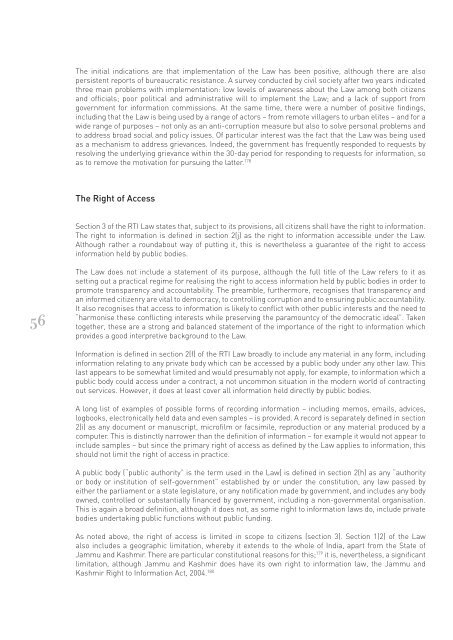Freedom of Information: A Comparative Legal Survey - Federation of ...
Freedom of Information: A Comparative Legal Survey - Federation of ...
Freedom of Information: A Comparative Legal Survey - Federation of ...
You also want an ePaper? Increase the reach of your titles
YUMPU automatically turns print PDFs into web optimized ePapers that Google loves.
56<br />
The initial indications are that implementation <strong>of</strong> the Law has been positive, although there are also<br />
persistent reports <strong>of</strong> bureaucratic resistance. A survey conducted by civil society after two years indicated<br />
three main problems with implementation: low levels <strong>of</strong> awareness about the Law among both citizens<br />
and <strong>of</strong>fi cials; poor political and administrative will to implement the Law; and a lack <strong>of</strong> support from<br />
government for information commissions. At the same time, there were a number <strong>of</strong> positive fi ndings,<br />
including that the Law is being used by a range <strong>of</strong> actors – from remote villagers to urban elites – and for a<br />
wide range <strong>of</strong> purposes – not only as an anti-corruption measure but also to solve personal problems and<br />
to address broad social and policy issues. Of particular interest was the fact that the Law was being used<br />
as a mechanism to address grievances. Indeed, the government has frequently responded to requests by<br />
resolving the underlying grievance within the 30-day period for responding to requests for information, so<br />
as to remove the motivation for pursuing the latter. 178<br />
The Right <strong>of</strong> Access<br />
Section 3 <strong>of</strong> the RTI Law states that, subject to its provisions, all citizens shall have the right to information.<br />
The right to information is defi ned in section 2(j) as the right to information accessible under the Law.<br />
Although rather a roundabout way <strong>of</strong> putting it, this is nevertheless a guarantee <strong>of</strong> the right to access<br />
information held by public bodies.<br />
The Law does not include a statement <strong>of</strong> its purpose, although the full title <strong>of</strong> the Law refers to it as<br />
setting out a practical regime for realising the right to access information held by public bodies in order to<br />
promote transparency and accountability. The preamble, furthermore, recognises that transparency and<br />
an informed citizenry are vital to democracy, to controlling corruption and to ensuring public accountability.<br />
It also recognises that access to information is likely to confl ict with other public interests and the need to<br />
“harmonise these confl icting interests while preserving the paramountcy <strong>of</strong> the democratic ideal”. Taken<br />
together, these are a strong and balanced statement <strong>of</strong> the importance <strong>of</strong> the right to information which<br />
provides a good interpretive background to the Law.<br />
<strong>Information</strong> is defi ned in section 2(f) <strong>of</strong> the RTI Law broadly to include any material in any form, including<br />
information relating to any private body which can be accessed by a public body under any other law. This<br />
last appears to be somewhat limited and would presumably not apply, for example, to information which a<br />
public body could access under a contract, a not uncommon situation in the modern world <strong>of</strong> contracting<br />
out services. However, it does at least cover all information held directly by public bodies.<br />
A long list <strong>of</strong> examples <strong>of</strong> possible forms <strong>of</strong> recording information – including memos, emails, advices,<br />
logbooks, electronically held data and even samples – is provided. A record is separately defi ned in section<br />
2(i) as any document or manuscript, micr<strong>of</strong>i lm or facsimile, reproduction or any material produced by a<br />
computer. This is distinctly narrower than the defi nition <strong>of</strong> information – for example it would not appear to<br />
include samples – but since the primary right <strong>of</strong> access as defi ned by the Law applies to information, this<br />
should not limit the right <strong>of</strong> access in practice.<br />
A public body (“public authority” is the term used in the Law) is defi ned in section 2(h) as any “authority<br />
or body or institution <strong>of</strong> self-government” established by or under the constitution, any law passed by<br />
either the parliament or a state legislature, or any notifi cation made by government, and includes any body<br />
owned, controlled or substantially fi nanced by government, including a non-governmental organisation.<br />
This is again a broad defi nition, although it does not, as some right to information laws do, include private<br />
bodies undertaking public functions without public funding.<br />
As noted above, the right <strong>of</strong> access is limited in scope to citizens (section 3). Section 1(2) <strong>of</strong> the Law<br />
also includes a geographic limitation, whereby it extends to the whole <strong>of</strong> India, apart from the State <strong>of</strong><br />
Jammu and Kashmir. There are particular constitutional reasons for this; 179 it is, nevertheless, a signifi cant<br />
limitation, although Jammu and Kashmir does have its own right to information law, the Jammu and<br />
Kashmir Right to <strong>Information</strong> Act, 2004. 180
















